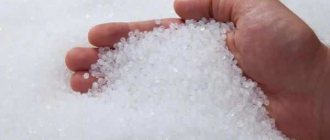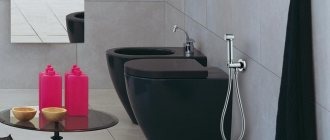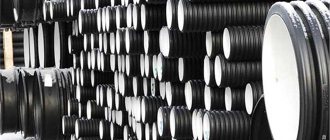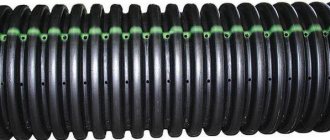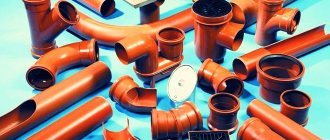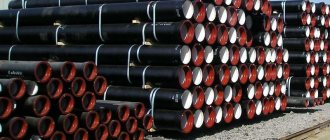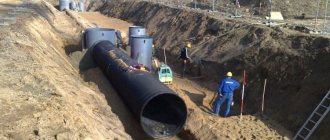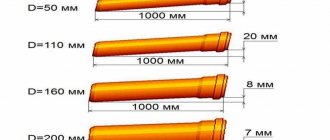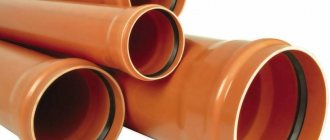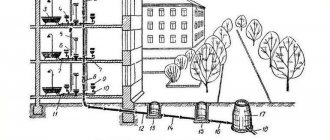All high-quality polyethylene pipes used to create engineering and communication systems in production must be marked. It can be seen on the surface of products. What does this set of numbers and letters say? It contains complete information about a specific product.
From the marking you can find out:
- who is the manufacturer;
- GOST regulating production;
- brand of polyethylene;
- diameter size;
- wall thickness;
- strength index characterizing the capabilities of the pipe - SDR.
Marking PE pipe
The PE pipe marking indicates that the raw material for production was polyethylene (PE), obtained by polymerization of ethylene, which has high thermal insulation and dielectric properties.
PE pipes are flexible, durable, and non-toxic, which allows them to be used for water pipes (including drinking water).
Advantages of PE pipes:
- polyethylene pipes do not react to alkaline preparations, hydrochloric acid, gasoline, alcohol, and various oils;
- resistant to impacts, do not crumble at sub-zero temperatures, pipe walls are vapor-tight;
- easy and simple installation by hot soldering. With proper operation, it can function for several decades;
- smooth internal and external surfaces are not subject to corrosion by salts, organic solvents, bacteria and microbes dissolved in water, and do not have limescale build-up;
- increased throughput compared to metal products;
- the high coefficient of linear expansion of polyethylene allows the pipe walls to stretch if the water freezes there in winter;
- polyethylene pipes do not require thermal insulation.
Advantages of using Polyethylene PE (HDPE) pipes
The wide range of applications of these products is explained by many advantages over their analogues made of metal, such as:
- products made of polyethylene have a warranty period of about 50 years;
- they are not exposed to moisture, aggressive environments, corrosion, stray currents, and do not require cathodic protection;
- are light in weight;
- installation is simple, while maximum tightness is achieved, and there is no need for professional equipment;
- the pipes are frost-resistant and do not burst even when the water in them freezes;
- due to the ideal inner surface of the pipe, no deposits form on the walls;
- prices for the purchase and installation of pipes are reasonable.
Synonyms: HDPE pipe, PE pipe, plastic pipe, polyethylene pipe, HDPE technical pipe, HDPE pipe for water supply, PE 100 pipe, PE sdr pipe, polyethylene pipe, polyethylene pipes.
You can buy HDPE pipes, as well as HDPE fittings and ask any questions you have from our managers by making a request by email or by calling the office at +7 (351) 777-94-98
SDR marking
SDR (Standard Dimension Ratio) is the ratio of the outer diameter of a polyethylene (or any other) pipe to the thickness of its wall.
Thus, with an increase in the SDR index, the pipe wall becomes thinner, and vice versa, the wall thickness increases with a decrease in the index, i.e. The higher the SDR value, the thinner the pipe.
Previously, the indicator of the performance characteristics of polyethylene pipes was the MRS (Minimum Required Strength) standard, which shows the minimum load under which the pipes will remain intact and undamaged.
GOST 18599-2001, which is called “Polyethylene pressure pipes,” regulates the quality of pipes and describes their main technical parameters, including the diameters of polyethylene pipes.
Marking
What does SDR indicate?
First of all, let's look at what SDR pipes are. So - this reduction indicates the ratio of the outer diameter to the wall thickness.
So, SDR is calculated using the formula – SDR=D/R, where:
- D – indicates the outer diameter,
- R – Wall thickness of the product.
Accordingly, the greater this value, the narrower the wall. For example, a pipe SDR 17 - its marking indicates that the outer diameter of the product is 17 times the thickness of the wall.
PE grades
In addition to SDR, when marking, a letter designation (“PE”) and a numerical designation consisting of two numbers are used. For example, a PE80 SDR11 pipe - as you might guess, PE indicates that the product is made of polyethylene. The numerical value corresponds to the minimum long-term strength of polyethylene (MRS), in this case it forms 8 MPa.
Products of the brands PE100, PE80 and PE63 are extremely popular. Pipe polyethylene, which is used in their manufacture, is obtained from a solid polymer with a high degree of crystallinity and a linear structure.
The main distinguishing feature of the products of these brands is strength and density. In addition, they have good resistance to organic and inorganic acids, alkalis, salts and other chemical elements. Indeed, their price is higher.
to declare that there are PE 32 SDR products, the production of which is regulated by GOST? 18599-2001. Much more often they are used in the field of sewerage water supply systems, with a nominal pressure of no more than 2.5 atmospheres.
Pipes PE 80 SDR 21
Low-pressure pipes used in private housing construction for non-pressure sewerage in a small one-story building, as well as drinking water supply. They are not suitable for creating pressure water systems in high-rise buildings, because thin walls will not withstand such a heavy load. Also, they cannot be buried in the ground; soil pressure can lead to an accident.
The SDR 21 marking indicates that with a constant load of 6 atmospheres and a water temperature of 20°C, the pipes will serve uninterruptedly for up to 50 years. They begin to deform at water temperatures above +40°C.
SDR polypropylene pipes
Polypropylene is classified as a material that does not have sufficiently high strength, unlike various grades of PE, unplasticized polyvinyl chloride, and polybutene. In addition, the material is connected by soldering, that is, taking into account the stated facts, its shell should not be too thin. Therefore, the maximum SDR of PE pipes is 17 and applies to products of 32, 40, 50 mm and above.
This suggests that when using popular PP pipes with a diameter of 32 mm with a shell thickness of 1.9 mm in hot water supply and heating systems, a much larger cross-section of the passage channel is obtained than when using a 25 mm PP pipe, the maximum SDR of which is 13.6 with the same wall of 1.9 mm.
That is, for the highest heating efficiency, installing 25 mm PP pipes is impractical and leads to increased hydraulic resistance of communications and, accordingly, an increase in fuel and electricity costs.
The minimum SDR of PP pipes is 5 and applies to products from 10 to 180 mm. These PP pipes are designed for use in high-pressure pipelines with pressure up to 25 atm.
Rice. 9 Classes of operation of thermoplastics according to GOST R 52134-2003
Related article:
Marking pn 20 on a plastic pipe, what it means and how to decipher it . In a separate article we talk in more detail about the marking and decoding of polypropylene pipes using the example of the 20th pipe.
Pipes PE 80 SDR 17
The polyethylene pipe SDR 17 is distinguished by the average value of the ratio of the outer diameter of the pipes produced today to the thickness of their wall. PE 80 SDR 17 pipes are recommended for use in a very wide range. For water supply systems intended to supply drinking water, for water supply systems for household purposes from water treatment facilities to the consumer, also for the installation of irrigation systems.
The choice of these pipes for installing communications in a low-rise building is considered optimal, since their installation will ensure high strength, lightness of the pipelines, and the cost of purchasing the material will be relatively low.
At a water temperature of 20°C, the pipes will withstand a load of 8 atmospheres. They are good for private housing construction, but such pipes are not suitable for high-rise buildings.
general characteristics
Sdr is the strength characteristic of a polyethylene pipe (abbreviated as HDPE), which can be used for the construction of water pipelines, working lines in a food industry, as well as gas pipelines.
It indicates the ratio of the outer diameter to the wall thickness. The higher this indicator, the correspondingly thinner the pipe wall and vice versa, if we are talking about samples having the same nominal diameter. This parameter is standardized for almost all types of pipes.
However, a small error in this parameter is allowed, which may be caused by the technical conditions of the production of a particular pipe, however, as a rule, this does not affect the performance characteristics of the products.
Technical characteristics of the pipe PE 100 SDR 21
Let's give an example: if we have two pipes with an indicator of 21 and 11 according to the SDR, but with a common diameter, the one with the designation 11 rather than 21 will be stronger. Accordingly, if we are talking about which one is better to install in a system with higher operating loads, it would be better to choose a product marked 11 rather than 21.
It would be advisable to follow this rule even if HDPE is selected for installation in gas pipelines or for working with other types of liquids. The use of certain pipes, as well as their main characteristics, are specified in GOST 8032, which regulates the standards of these products.
Basic indicators
This indicator can range from 40 to 6, depending on the type of pipe, as well as its purpose. Samples 17, 21, 11 are often found. Models 17, as well as sdr11, are often chosen for a wide range of jobs.
The second, most common marking for such pipes is the designation PE. It just indicates the brand of polyethylene.
Table of comparative characteristics of PE 80 and PE 100 pipes
Most often you can find on sale samples marked PE 63, 80, PE100, 160 and higher. Let's take a closer look at their following major differences:
- A material with a lower index requires a lower soldering temperature.
- Polyethylene 100 samples have a slightly different structure of the material, more ordered than in the version with a lower index, which makes it possible to obtain a more even seam during processing of the material.
- Sample 100 is generally more durable; accordingly, it can be used under various operating conditions, including the most severe.
- The cost of producing samples marked 80 is higher than those with a higher indicator, since their production usually requires a larger amount of material.
Similar patterns in the ratio of production prices, as well as material processing features, apply to models with an indicator of 63, 160, which in recent years has also been purchased for some home networks.
Technical characteristics of HDPE pipes (video)
Pipes PE 80 SDR 13.6
PE 80 SDR 13.6 pipes are low-pressure pipes and are recommended for use in the installation of pipelines transporting cold drinking water for various needs in country houses, and pipes allow the transport of liquid food products (wine, juice, milk). Compared to cast iron or steel pipes, polyethylene analogues are much stronger, while they are lightweight and are installed by hot soldering.
They belong to the category of products made from low-density polyethylene, which makes them the most durable among the PE-80 brand. After all, its working pressure can be considered 10 atmospheres. The pipe walls are able to withstand a temperature range from -40°C to +60°C, so they can be used in northern latitudes.
Polyethylene grades
Grade PE 80, PE 63, PE 100 corresponds to the strength index MRS 8; 6.3 and 10, i.e., means the minimum long-term strength of the polyethylene from which these pipes are made. Pipe polyethylene of these grades is obtained from a rigid polymer with a linear structure and a high degree of crystallinity. These products have good resistance to most inorganic and organic acids, petroleum carbons, alkalis, salts, etc.
Polyethylene grades PE 100, PE 80 and PE 63 are widely used nowadays; its main distinguishing feature is density, strength and, of course, cost.
PE 32 SDR pipe is also produced, its quality is regulated by GOST 18599-2001, its scope of use is water supply (at a nominal pressure of 2.5 atm.) and sewerage.
It seems that PE 100 is the most reliable, durable and cheaper grade of polyethylene; in fact, each of these grades has its own individual application.
Gas pipe
In addition, such pipes have a visual difference depending on their purpose. For example, pipes with a blue stripe are used to install a drinking water supply system, and products with a yellow stripe are used to lay a gas pipeline.
PE 100 pipe
It is characterized by high working pressure, maximum tensile strength and resistance to mechanical stress. Certified raw materials are used for its production. Qualitative characteristics made it possible to reduce the wall thickness of this product and reduce its weight. Pipes of this brand are most often used for the following purposes:
- installation of water and gas pipelines;
- installation of pipelines for supplying food products in liquid form (juices, milk, wine, beer, etc.).
PE pipeline installation process
PE 80 pipe
These products are wear-resistant, quite lightweight, and medium-pressure plastic is used for their manufacture. Pipes of this brand belong to low-pressure pipes, the main purpose of which is the installation of low-pressure and free-pressure sewerage systems in multi-apartment residential buildings. In addition, they can be used to install small-diameter pressure water supply in a small area.
The products are certified and can be used for their intended purpose.
PE 80 pipe
At the same time, experts do not recommend using them in some cases. Due to the small thickness of the wall, it is not recommended to install gas pipelines and main pipelines from such products.
PE 63 pipe
This grade of polyethylene contains mainly ethylene molecules; it is characterized by short-term strength, but at the same time it is prone to cracking and destruction. Due to these characteristics, it is less often used in civil and industrial construction for the construction of drainage systems of road communications, basements of buildings, foundations and sites.
These pipes are used in the laying of electrical cables and fiber optic lines, where they are used as a casing for utility lines. Sometimes these pipes are used in agriculture; with their help, moisture is drained from waterlogged areas and swamps.
PE 100 SDR 26
For the production of such pipes, PE100 polyethylene is used, the distinctive qualities of which are high density, due to which pipes made from this material are superior to products made from PE80 in many respects, including long-term strength and resistance to cracking.
These pipes are used for transporting household and drinking water in urban areas and outside the city; they can also be used in sewerage systems, when drilling artesian wells, and creating a reclamation system. In factories and factories they will serve to supply milk, juice or wine.
In addition, the quality indicators of the material made it possible to significantly reduce the thickness of the walls of the product, which lightened its weight, but at the same time their throughput was 10-15% higher. The working pressure can be considered 6.3 atmospheres.
PE 100 SDR 21
PE 100 SDR 21 pipes are used for the construction of water pipelines. Passing through pipes of this type, water retains its taste and is characterized by the absence of foreign odors. They are often used not only in suburban construction, but also to create reclamation and irrigation systems, and when installing suburban water supply systems. High-strength polyethylene can withstand high pressure, and PE 100 SDR 21 pipes can be used as an element of a cold water supply system in high-rise buildings.
These pipes have excellent strength characteristics and are ideal for water supply. They are compatible with metal pipes (steel, cast iron) using special adapters. Corrosion processes, other types of destruction and blockages in such pipes are not dangerous. At a constant water temperature of +20°C, the pipes can withstand a pressure of 8 atmospheres.
PE 100 SDR 17
Pipes marked PE 100 SDR 17 are new generation pipes. Their feature is uniquely high strength indicators, which has a significant impact on enhancing the performance characteristics of polyethylene pipes. They tolerate constant pressure of 10 atmospheres well.
Pipes of this type are recommended for use in pressure water supply systems and gas pipelines. Moreover, such pipes are considered ideal for the installation of pipelines with a large cross-section. When manufacturing pipes of this type, material savings are very significant due to the possibility of reducing the wall thickness while maintaining the high strength of the product. The technical characteristics of such pipes allow their widespread use in the construction of long-distance pipelines.
SDR polyethylene pipes
Specifications for pipes made of polyethylene (PE) are given in GOST 18599-2001. According to the state standard, PE pipes are produced from the following grades of polymers: PE-32, PE-63, PE-80, PE-100.
Currently, varieties of polyethylene PE32, PE63, and even PE80, due to their low physical characteristics, are obsolete and are practically not used in the manufacture of pressure pipes.
According to GOST, the SDR of the 80s and 100s of PE pipes lies in the range of values from 6 to 41.
At the same time, for diameters used in everyday life from 25 to 50 mm, the highest RDD of 26 units is for PE pipes measuring 50 mm. They are able to withstand pressures of 5 and 6.3 bar, respectively, for PE-80 and PE-100, while their wall cross-section is 2 mm.
It follows from this that theoretically such a 50 mm PE pipe can be used for casing shallow Abyssinian wells, like all smaller pipes that have a lower SDR, a correspondingly larger shell thickness, and are able to withstand higher pressure.
In gas pipeline networks of private houses and apartments, gas pressure is low and does not exceed 0.05 atm. That is, any PE pipe is suitable for supplying it to the house, the least durable of which can withstand loads at least 100 times greater.
Rice. 5 SDR and pressure characteristics of PE pipes according to GOST 18599-2001
When using PE pipes as pressure pipes in individual water supply, it should be taken into account that their maximum withstand pressure is 25 bar with a minimum SDR of 7.4 for PE-100 and 6 units for PE-80.
If we consider the thickness of the shell of a 1-inch 25 PE pipe, then in the first case (for PE-100) it will be 3.5 mm, and in the second (for PE-80) - 4.2 mm. That is, the use of a pipeline made of PE-80 will lead to a decrease in the passage channel, which means an increase in hydraulic losses, as a result, a decrease in the efficiency of the entire system and unjustified financial costs for electricity to power electric pumps.
Therefore, in domestic water supply there is no alternative to pipes made of PE-100. When selecting them, it is advisable to calculate the pressure in the main and select a product with the minimum permissible shell thickness (with some margin), that is, with the highest SDR.
For example, if the maximum pressure in the main line is 10 bar and a PE pipe of 32 mm (1 inch) is used, according to the tables from GOST 18599-2001 it is rational to choose a product made of PE-100 with a shell thickness of 2 mm and SDR 17 (or S 8 series) .
Rice. 6 Marking of PE pipes
PE 100 SDR 11
The PE100 SDR 11 pipe is made from polyethylene produced at low pressure. At the same time, the high density of the material allows the use of such pipes for water supply systems with high pressure. The material used for the manufacture of pipes ensures high quality and environmental safety of drinking water.
Reliable and strong, they are able to withstand constant pressure of 16 atmospheres for 50 years. Such reliability and tolerance to aggressive environments makes it possible to use these pipes for gasification of populated areas. They are not afraid of stray currents, they can easily withstand variable soil loads. Pipes of this brand can be laid using the pulling method in the ground. The density of polyethylene allows them to be used as sewer collectors.
